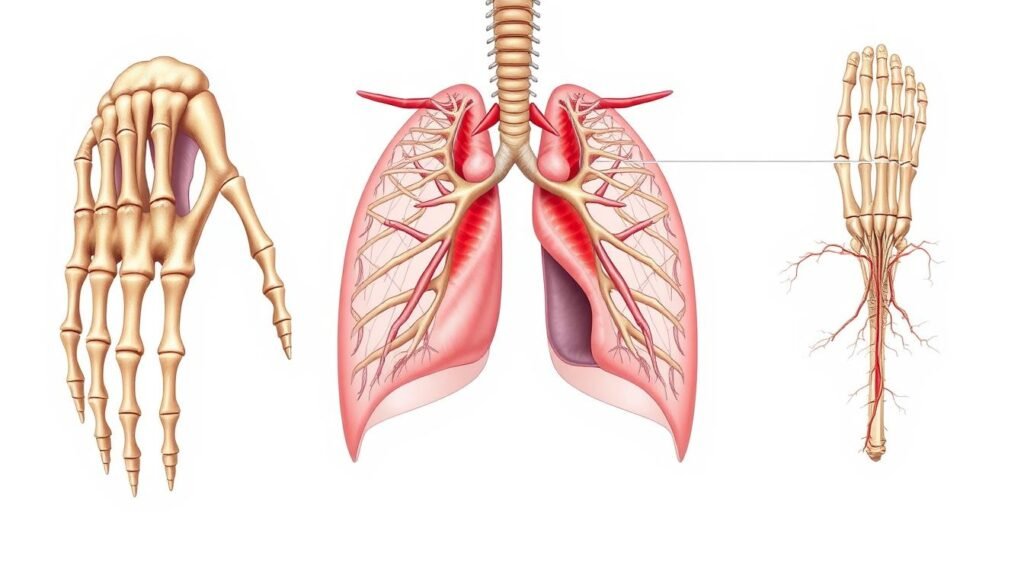About 20% of lung cancer cases are metastatic at diagnosis. They often show symptoms like foot pain, which seems unrelated. This connection is key for patients and healthcare pros. Foot pain might indicate problems from lung cancer spreading.
This piece explores how lung cancer can cause foot pain. It underlines the need to spot lung cancer signs early. We cover how foot pain can come from cancer spreading, options for diagnosis and treatment. Our goal is to fully explain this worrying issue. Readers will learn how lung cancer affects foot health and life quality.
Key Takeaways
- Lung cancer foot pain can be an alarming indicator of metastasis.
- Understanding lung cancer symptoms is essential for early diagnosis.
- Foot pain may result from rare acrometastases linked to lung cancer.
- Timely intervention can significantly improve outcomes.
- Metastatic lung cancer often misdiagnosed as common foot problems.
- The prognosis for patients exhibiting foot metastases tends to be poor.
Understanding Lung Cancer and Its Symptoms
Lung cancer is a top cause of cancer deaths in the United States. It mainly comes in two types: non-small cell and small cell lung cancer. Spotting it early is hard because symptoms often don’t show up until it’s advanced.
Signs of lung cancer include:
- Persistent cough
- Difficulty breathing
- Chest pain
- Fatigue
Some people with early lung cancer do notice symptoms. These can be weight loss, breathlessness, and unusual tiredness. If you have these signs, talk to a doctor. Catching it early can improve chances of beating it.
When lung cancer gets worse, it can cause more problems. It might spread and make legs and feet swell. This happens when tumors block lymph paths or from treatments like chemotherapy. Knowing these signs helps find and treat lung cancer early.
What is Lung Cancer Foot Pain?
Lung cancer foot pain is discomfort in the feet linked to lung cancer. This pain often comes from metastatic disease. This means the cancer spreads to separate parts of the body. A rare occurrence is acrometastasis, where cancer reaches the foot bones, causing pain.
Sometimes, foot pain is the first sign of trouble. Even though it’s rare, it shows why doctors must be careful to find the cause of any foot pain. Lung cancer might spread to the heel bone but is often mistaken for simple heel pain.
The issue with lung cancer foot pain is not just the discomfort. Finding it late might mean fewer treatment choices. Smokers might report foot pain as a sign of lung cancer. So, it’s key that those with foot pain get checked out fast.
Figuring out the cause of foot pain can be hard. It might seem like it’s from common issues like plantar fasciitis or Achilles tendinitis. Keeping feet healthy by supporting the arch, wearing the right shoes, and doing certain exercises is crucial.
Common Symptoms of Lung Cancer
Lung cancer shows signs that go beyond just breathing problems. Chronic cough and shortness of breath are common. These could mean the cancer is getting worse. They might lead to other issues if not dealt with.
More symptoms include:
- Chest pain
- Weight loss and fatigue
- Systemic symptoms such as fever or night sweats
- Loss of voice or hoarseness due to chronic coughing
- Swelling or discoloration of the upper body
Spotting these signs early can make treatments work better and may stop cancer from spreading. It’s key for patients to watch out for odd symptoms. For example, clubbing of the fingernails is a strong sign for smokers.
Pain in the arm and shoulder can happen as the disease hits close nerves. This makes the overall condition of the patient worse. In late stages, people might face severe issues like Horner syndrome, which causes facial paralysis.
For more information on symptoms, check out this resource. Catching it early is vital. In 2021, lung cancer caused about 132,000 deaths in the US. This is a large part of all cancer deaths.
Why Does Lung Cancer Cause Foot Pain?
Lung cancer can cause foot pain in a few ways. Cancer metastasis is a main cause. When cancer from the lungs spreads, it may reach the feet’s bones. This causes pain and discomfort.
This pain happens because the cancer affects the bones directly. Knowing how lung cancer can lead to foot pain is important. It helps with quick diagnosis and treatment.
Another cause of pain is paraneoplastic syndrome. This syndrome is the body’s reaction to cancer. It can lead to many symptoms, including pain in the feet. This shows how cancer affects the body in complex ways.
If someone with lung cancer starts having foot pain, they should see a doctor right away. Being quick to report changes can help doctors find underlying issues. For more details, click here.
Exploring Cancer Metastasis and Its Impact
Cancer metastasis is when cancer cells move from the main tumor to other body parts. This spread has a big impact on patient’s health futures. In lung cancer, these cells often move to bones, liver, and brain. It’s key to know how this spread affects the body for better treatment.
Bone metastases are more common than primary bone cancer. They largely affect those with breast, prostate, lung, kidney, and thyroid cancers. Patients often feel bone pain, especially at night, and might have swelling or fracture risks. As the condition gets worse, they might face hypercalcemia, leading to constipation, nausea, and intense thirst.
Metastatic disease can also press on the spinal cord, causing severe problems. This can make legs weak, disturb balance, and lead to incontinence in harsh cases. Tools like x-rays, MRIs, and CT scans are crucial for finding bone metastasis. They help doctors decide how to treat it best.
Treating bone metastases often involves radiation and medications like bisphosphonates and denosumab. They aim to lessen symptoms and help patients live longer. Catching and treating this disease early is very important. The future for lung cancer patients with metastasis depends on many things. This includes how far the cancer has spread and how well treatments work. Regular check-ups and full care are essential.
Signs of Cancer Metastasis to the Foot
It’s important to know the signs of cancer spreading to the foot early. You might feel swelling, pain, or tenderness in your foot. Your skin may also change color or texture. If walking becomes hard or you start to limp, you should see a doctor right away.
Lung cancer is the main cancer that spreads to the foot, in 28.3% of cases. Endometrial cancer comes next at 17.4%, followed by breast cancer at 10.9%. Often, discovering cancer in the foot is the first clue that someone has cancer. Doctors must pay attention to these signs, especially in patients with a history of cancer.
In a study of 46 people with cancer in the foot, most were women (54.4%). The average age was 63.2 years. The cancer usually affects the heel and forefoot bones. Few people have surgery, as most get care to ease symptoms. Sadly, about half of these patients pass away within two years.
| Primary Tumor Type | Percentage of Cases |
|---|---|
| Lung Cancer | 28.3% |
| Endometrial Cancer | 17.4% |
| Breast Cancer | 10.9% |

Lung Cancer Foot Pain: Diagnosis and Diagnosis Process
The first step in diagnosing lung cancer foot pain is a detailed patient history and a physical check. Doctors look for any warning signs that might point to lung cancer. This is a critical part of the process.
Imaging tests, like X-rays, CT scans, or MRIs, are vital. They can show lesions that might mean cancer has spread. These tests let doctors see what’s happening inside the body and spot any lung issues.
At times, a biopsy could be needed to check for cancer cells. Doctors take a small sample from the area that looks suspicious. Pathologists then examine this sample to confirm if cancer is present. If blood tests show high levels of inflammation, it might also mean cancer.
Knowing the signs of lung cancer foot pain is important. It helps patients and their families seek help early on. Learning about the symptoms and how doctors diagnose the condition is empowering. For more about lung cancer signs, check this resource.
| Diagnostic Method | Description |
|---|---|
| Patient History | Gathering detailed information about symptoms and medical background. |
| Physical Examination | A clinical assessment to identify any physical signs of the disease. |
| Imaging Tests | X-rays, CT scans, and MRIs to visualize abnormalities. |
| Biopsy | Removing samples of tissue for laboratory analysis to confirm cancer. |
| Inflammatory Markers | Blood tests to check for elevated levels indicating possible malignancy. |
Basic Treatment Options for Lung Cancer Foot Pain
Treating lung cancer foot pain means tackling both the cancer and its symptoms. There’s a variety of treatments like chemotherapy, radiation, or targeted therapy. These treatments are aimed at slowing cancer and easing symptoms.
Cancer pain management is key for those suffering from foot pain because of lung cancer. Pain can be dull, achy, sharp, or burning. Each type needs a specific approach to manage it. Most pain can be treated, combining over-the-counter and prescription drugs, including opioids.
Non-drug therapies are also crucial in managing cancer pain. Nerve blocks, acupuncture, and massage can help relieve pain. Keeping a pain diary helps track pain levels. This makes communicating with doctors easier, improving treatment outcomes.
The table below summarizes different treatment modalities for lung cancer foot pain:
| Treatment Option | Type | Description |
|---|---|---|
| Chemotherapy | Systemic | Uses drugs to kill cancer cells and manage symptoms. |
| Radiation Therapy | Localized | Applies high-energy particles to reduce tumor size and relieve pain. |
| Opioids | Medication | Powerful pain relievers for moderate to severe pain. |
| Nerve Blocks | Procedural | Involves injecting anesthetic near nerves to alleviate pain in specific areas. |
| Acupuncture | Integrative | Utilizes fine needles to alleviate pain and improve overall well-being. |

Palliative care plays a crucial role in enhancing life quality for lung cancer patients. It involves teams creating tailored pain management plans. These plans focus on the patient’s needs and goals. Directing patients to pain management programs ensures they get full care under their insurance.
It’s vital to communicate pain levels effectively with healthcare providers. Using a 0 to 10 pain scale helps describe discomfort. This leads to better treatment adjustments, ensuring patients get the best care possible.
Cancer Pain Management Strategies
Managing pain from lung cancer is key for patients. There are many treatments and medicines that help ease this discomfort. We’ll look at options like NSAIDs and bisphosphonates. These can help with lung cancer-related pain.
Non-Steroidal Anti-Inflammatory Drugs (NSAIDs)
NSAIDs are crucial for managing cancer pain. They lower inflammation and ease discomfort. This is especially true for pain in the bones caused by cancer. Medicines like ibuprofen and naproxen are common.
They help patients move better and control their symptoms. But, it’s important to use these medicines as directed. This helps avoid any bad side effects.
Role of Bisphosphonates in Treatment
Bisphosphonates are also important in treating cancer pain. They’re great for issues related to the skeleton. These drugs slow down bone loss. This eases pain from cancer spreading to bones.
By easing bone pain and lowering fracture risks, bisphosphonates make treatment more bearable. They really help improve patients’ comfort.
| Medication Type | Mechanism of Action | Common Examples | Benefits |
|---|---|---|---|
| NSAIDs | Reduce inflammation and provide pain relief | Ibuprofen, Naproxen | Improved mobility, effective pain relief |
| Bisphosphonates | Inhibit bone resorption | Zoledronic Acid, Pamidronate | Reduce pain associated with bone metastases, decrease fracture risk |
In summary, NSAIDs and bisphosphonates are key for managing cancer pain. Healthcare providers can choose the best treatment for each patient. Keeping track of pain helps adjust treatments to get the best results. This is essential for those with lung cancer foot pain.
Understanding Hypertrophic Pulmonary Osteoarthropathy (HPOA)
HPOA is a rare condition mainly linked with lung cancer. It causes clubbed fingers, bone growth on long bones, and joint pain. These signs are critical to spotting the disease.
Lung cancer, especially adenocarcinoma, is the top cause of HPOA. A study in Japan found 87.1% of lung cancer HPOA patients were men. Adenocarcinoma was identified in 59.4% of these patients. It’s also noted that HPOA is more common with certain lung lesions.
Every person with lung cancer HPOA talks about joint pain, with 84.2% feeling it in their legs. About a quarter face swelling in their limbs. Yet, a large number, 88.3%, feel better after cancer treatment.
Understanding the link between HPOA and cancer is crucial for treatment. It helps in finding ways to reduce bone inflammation and ease pain. This makes managing cancer and HPOA symptoms easier.

Lung Cancer Foot Pain in Patients with Malignant Pleural Effusion
People with lung cancer may feel a lot of discomfort. This is due to malignant pleural effusion, where fluid builds up around the lungs. The buildup causes added foot pain. Patients often have to deal with various symptoms, making their care more difficult.
Swelling in the feet and legs is common with malignant pleural effusion. It leads to a heavier feeling and skin texture changes. Difficulty in moving and increased discomfort may occur. Management includes compression garments, better diet, and exercise to boost blood flow.
Removing fluid from around the lungs is sometimes needed. This therapy helps ease breathing problems and the pain in the feet tied to lung cancer. People having chemotherapy may see their swelling get worse, adding to their challenges.
Experts say ongoing check-ups and care for lung cancer issues like malignant pleural effusion matter a lot. They make life better for those affected.
| Condition | Symptoms | Treatment Options |
|---|---|---|
| Malignant Pleural Effusion | Fluid accumulation, respiratory distress, foot pain | Therapeutic drainage, diuretics, physical therapy |
| Peripheral Edema | Swelling, heaviness in limbs, skin changes | Compression garments, elevation, dietary adjustments |
| Venous Thromboembolism | Swelling, pain, discoloration in legs | Anticoagulants, lifestyle modifications, regular monitoring |
Conclusion
Lung cancer foot pain is a warning sign that should never be ignored. It often points to the cancer spreading. Early detection is key to starting treatment quickly. This can lead to better results for lung cancer patients.
Foot pain from cancer is uncommon but important for doctors to think about. It can look like less serious problems, making it tough to diagnose right away. Doctors and nurses can learn more from resources like this case study.
Teamwork in healthcare can greatly improve life for those with lung cancer foot pain. Treatments that care for both body and mind help a lot. Keeping up with new information on cancer spread is crucial. So is good communication between patients and their medical teams.